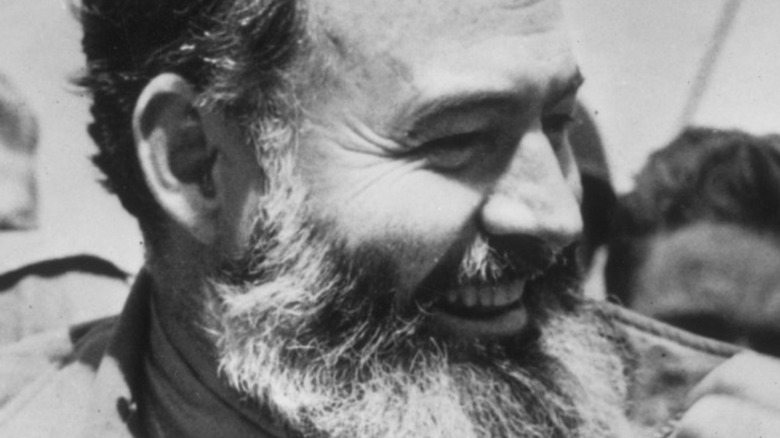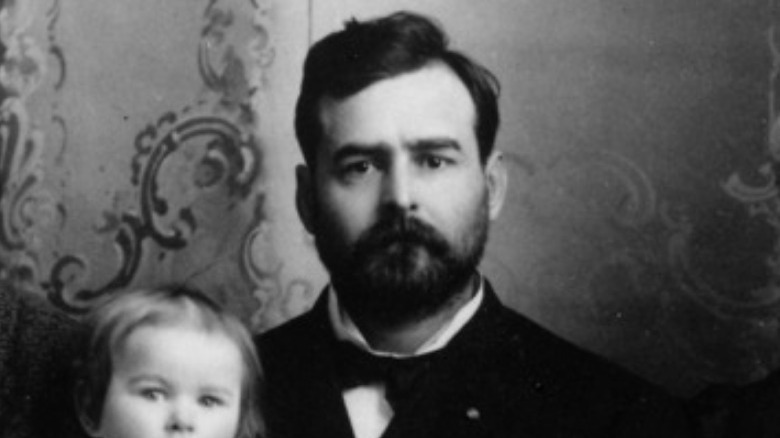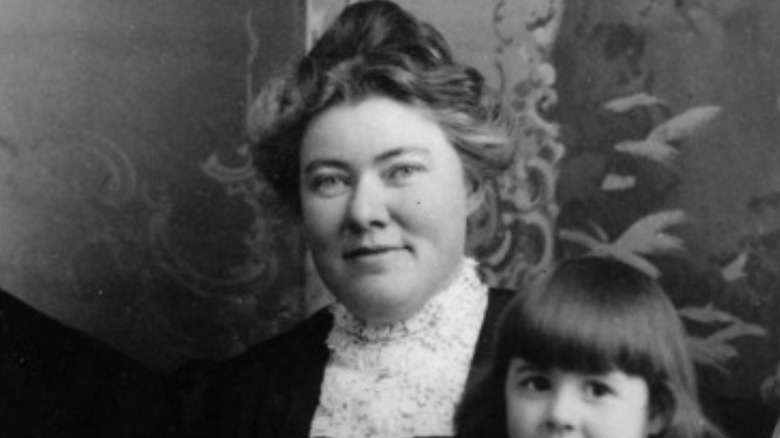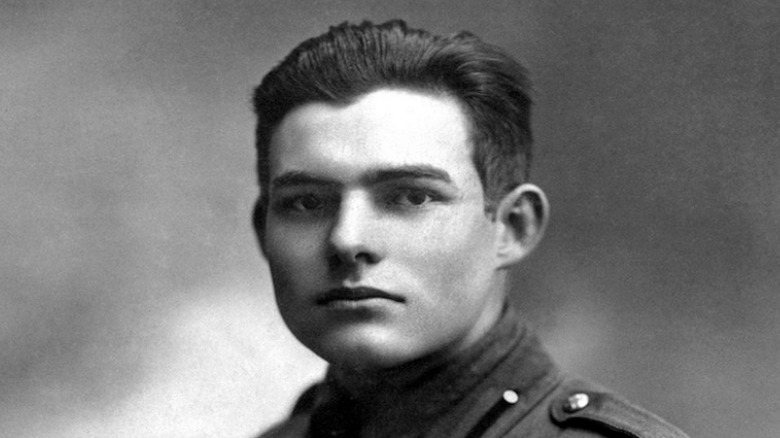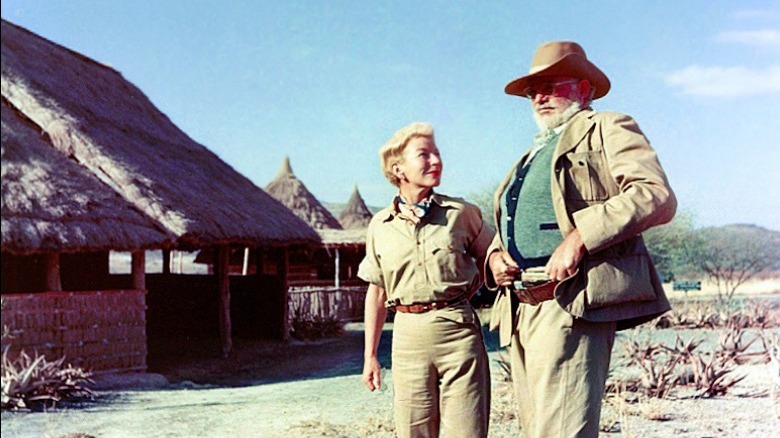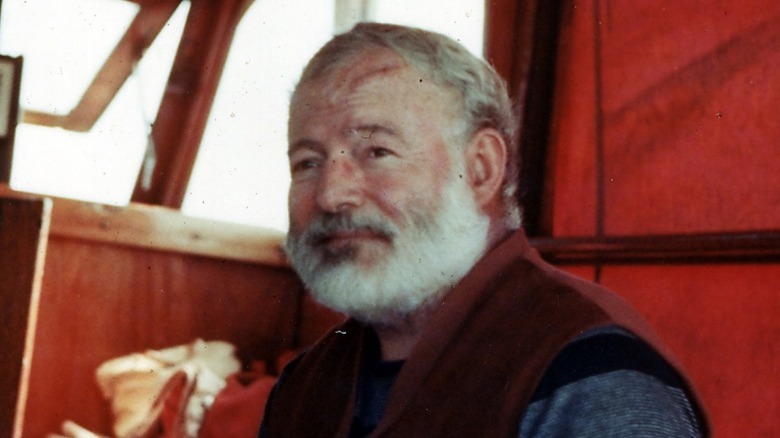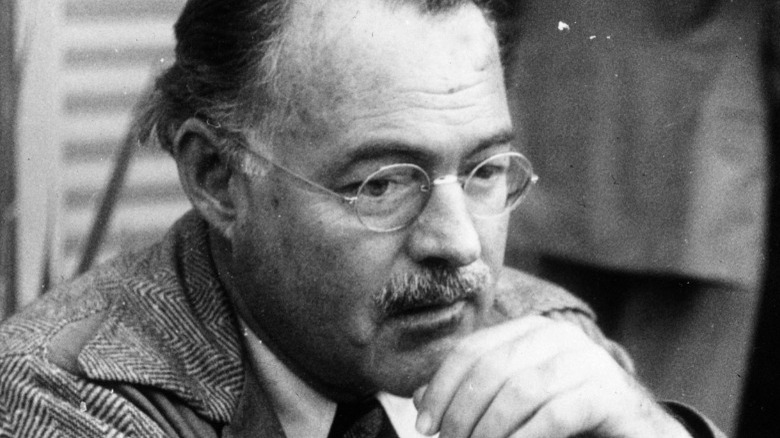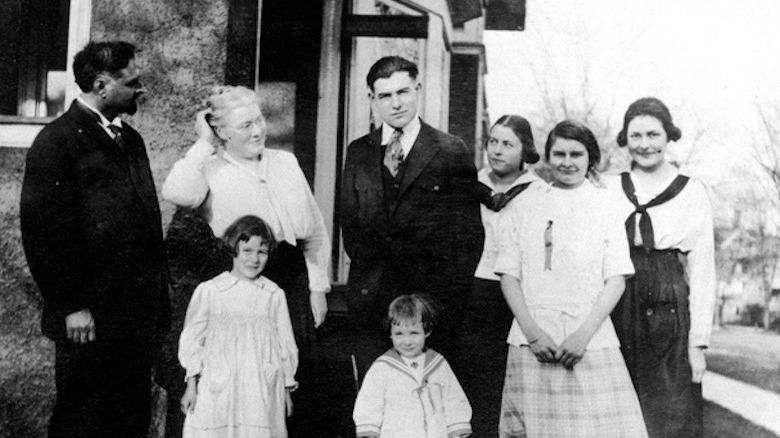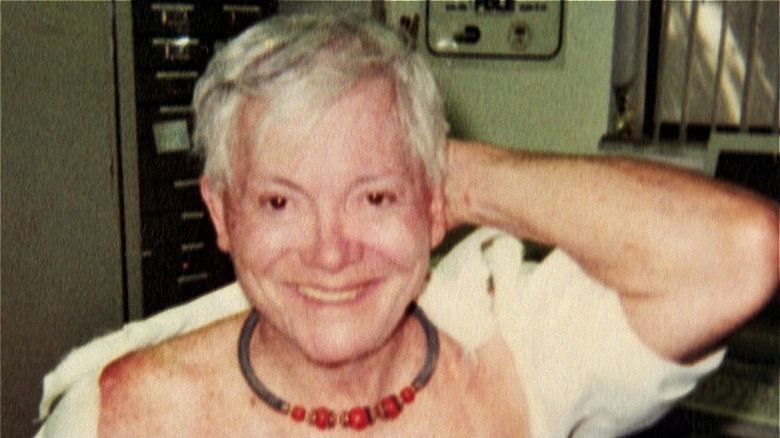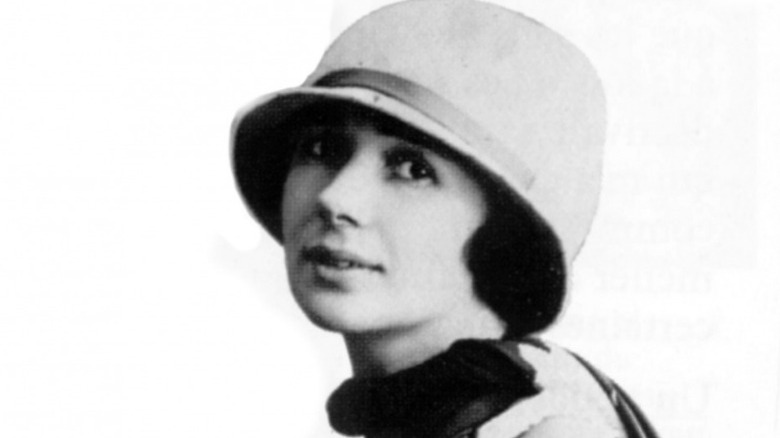Tragic Details About The Hemingway Family
Described by The New York Times as the most outstanding living writer since the death of Shakespeare (at the time), Ernest Hemingway is among English literature's most lauded authors. The Nobel Prize-winning author is celebrated for novels such as "A Farewell to Arms," "For Whom the Bell Tolls," and "The Old Man and the Sea."
However, despite renown and riches, Hemingway was a fatally troubled man, and his suicide in the summer of 1961 was neither the first nor the last tragedy for the Hemingway family, which has been described as "cursed" (via Distractify). The first suicide came in 1928, when Ernest's father Clarence shot himself dead. And after Ernest's death, two of his siblings died at their own hands in 1966 and 1982. This genetic disposition also reached granddaughter Margaux, who ended her life in 1996.
So, from Ernest the iconic patriarch to Margaux the haunted supermodel, here are the tragic details about the Hemingway family.
If you or anyone you know is having suicidal thoughts, please call the National Suicide Prevention Lifeline at 1-800-273-TALK (8255).
His father committed suicide
Ernest Hemingway was 29 years old when his father, Dr. Clarence Hemingway, committed suicide on December 6, 1928 (via Biography). According to Geni, Clarence was suffering from diabetes and angina pectoris, issues that were compounded by growing financial issues. Before the sad end of his life, Clarence was a successful and conscientious man, although he could have a violent, bullying temper. Biographer Jeffrey Meyers wrote (per Geni), "He promised that [his wife Grace] would never have to do housework and kept his word. He always prepared the children's breakfast and served Grace in bed. He bought the groceries, did most of the cooking, took care of the laundry and managed the servants despite his medical responsibilities."
Outside of the home, Clarence would enjoy nature with Ernest, teaching him fishing, shooting, and hunting. Ernest would draw on these experiences in writing Nick Adams, the protagonist in short stories such as "Big Two-Hearted River." Sadly, life became too painful even for this most energetic of men. After shooting himself with a Smith & Wesson .32 revolver, Clarence's son Leicester described the tragic scene in his third-person novel "The Sound of the Trumpet": "There on the bed lay his father, making hoarse breathing noises. His eyes were closed, and in that first instant as he saw him there in the half-dark, nothing looked wrong. He put his hand under his father's head. His hand slipped under easily and when he brought it out again, it was wet-warm with blood."
He hated his mother
Ernest Hemingway and his father, Clarence, had much in common. However, he had no such connection with his mother, Grace, who abandoned her career as an opera singer to be a wife and mother, which she liked to remind people of on a regular basis (via The Washington Post).
She likely mentioned this grievance to her students, whom she taught music and vocals at the Hemingway home in Oak Park, Illinois. The extroverted Grace was so successful as a teacher that she outearned Clarence, a physician. She liked to remind people of that fact, too. Ultimately, Grace's theatrical persona became a burden on her family. She exposed her children to the arts, but she would also pressure them, saying that if they loved her, they would do what she wanted. It was Clarence who received the sharpest end of her personality, though. As Ernest grew older, he came to view his father as weak and submissive and blamed his mother for Clarence's deteriorating mental health.
Then there were the curious ways in which Grace would treat Ernest and his sister Marcelline. She dressed them as girls and sometimes as boys and would pass them off as twin girls in public. According to biographer Mary Dearborn (via the Daily Mail), this caused in Ernest a "long ambivalence about and fascination with gender roles and sexuality."
As Ernest became a man, his aversion to his mother turned to hatred. "I hate her guts, and she hates mine. She forced my father to suicide," he said, per The New York Times. When Grace died on June 28, 1951, Ernest did not attend her funeral.
He was injured in the First World War
According to History, Ernest Hemingway was working as a reporter for the Kansas City Star when World War I broke out in the summer of 1914. A few years later, before the United States entered the war on April 6, 1917, Hemingway volunteered for the Red Cross and was stationed in France.
Later, he was sent to the Italian front, where he served as an ambulance driver aged just 18 (via National Archives). On the night of June 1918, Hemingway and two Italian soldiers were struck by Austrian motor shells, dispersing the men and covering them in mud and detritus. Knocked unconscious, shell and shrapnel had punctured Hemingway's foot, knee, thighs, scalp, and hand. His comrades were less fortunate — one died immediately, while the other had both legs blown off, killing him later that evening.
When Hemingway regained consciousness, he noticed another injured man and, despite his numerous wounds, carried him to safety under machine-gun fire, receiving yet another injury. Hemingway lost all memory of this until an Italian officer informed him of his bravery, for which he was awarded the Silver Medal of Valor. Hemingway wrote in a letter (per History), "Everything is fine and I am very comfortable." However, the attack also elicited somber reflection: "When you go to war as a boy you have a great illusion of immortality. Other people get killed; not you ... Then when you are badly wounded the first time you lose that illusion and you know it can happen to you."
Hemingway was in two plane crashes that seriously affected his health
Ernest Hemingway was drawn to danger. In 1935, he managed to shoot himself in both calves while shark fishing off Key West, an experience he documented for Esquire (via Time). Under the headline "On Being Shot Again," Hemingway conceded that he had "shot himself in the calves of both legs," adding how best to kill a dangerous animal: "Shoot it in the brain if it's close, the heart if it's far or the spine if you need to stop it instantly."
It seems Hemingway was not especially bothered by that mishap, given the nonplussed tone of his prose. However, in 1954, the writer suffered not one but two plane crashes during a chaotic safari, and these were not so easy to shrug off. According to The New York Times, Hemingway and his wife Mary were flying over Uganda when the pilot ditched the Cessna to avoid a flock of ibises. The pilot had two landing options: a sandpit occupied by six basking crocodiles or an elephant track in dense jungle. He chose the latter, landing with only minor damage.
After a night in the jungle, Hemingway and Mary boarded another plane, which proceeded to catch fire and crash. Time reported that they emerged in high spirits, with Hemingway quipping, "My luck, she is running very good." However, the second crash left Hemingway with a concussion, burns, cracked ribs and vertebrae, and a ruptured liver, spleen, and kidneys (via Hektoen International). Biography notes that this accident caused a marked decline in Hemingway's physical and psychological well-being.
He was dogged by mental illness
Ernest Hemingway was world famous for his masculine image, which was built in part by photographs of the writer boxing, shooting, and fishing. His prose, too, was described as "muscular" and "taut," according to PBS. To many, Hemingway personified the "strong silent type." Yet his writing and his image belied a man tortured by serious mental health issues. According to Dr. Howard Markel (via PBS), Hemingway suffered from "severe depression, paranoid delusions and bipolar disease exacerbated by a history of alcoholism, severe head injuries and a genetic disorder of iron metabolism known as hemochromatosis, which can also cause intense fatigue and memory loss."
By 1960, Hemingway was in a very bad place. He entered the Mayo Clinic using an alias, staying there for two months, ostensibly for hypertension. The real reason was acute depression, and he underwent electroshock convulsive therapy (ECT) some 15 times in an attempt to cure it (via PBS). Alas, the therapy failed to relieve Hemingway of his mental health issues, which were only getting worse as he entered his 60s.
The effectiveness of ECT has been questioned in recent years. According to the BBC, a study found that there was "no place" for ECT in evidence-based medicine owing to reports of brain damage. The Ethical Human Psychology and Psychiatry journal concluded, "The high risk of permanent memory loss and the small mortality risk means that its use should be immediately suspended."
If you or someone you know is struggling with mental health, please contact the Crisis Text Line by texting HOME to 741741, call the National Alliance on Mental Illness helpline at 1-800-950-NAMI (6264), or visit the National Institute of Mental Health website.
He committed suicide
In January 1961, Ernest Hemingway was given a clean bill of health and discharged from the Mayo Clinic by Dr. Howard Rome (via PBS). In retrospect, it is hard to understand how Hemingway was given this appraisal, for the writer was becoming dangerously close to realizing his suicidal ideation. Three months later, his wife Mary found him posturing dangerously with his favorite shotgun, scaring her so much that she rushed her husband to Sun Valley Hospital and then the Mayo Clinic, where he received further bouts of electroshock convulsive therapy.
During the flight to the Mayo Clinic in Rochester, Minnesota, the plane landed to refuel in South Dakota. As Hemingway disembarked from the aircraft, he is said to have walked towards the propellers, which lost momentum just before he reached them. Hemingway returned home to Ketchum, Idaho, on June 30, 1961. Two days later, on the morning of July 2, Hemingway rose and walked to the basement, where he retrieved his 12-gauge double-barreled shotgun, pocketing two shells. Moments later, in the foyer of his oaken house, Hemingway placed the gun in his mouth and fired both barrels (via Minneapolis St. Paul). The gunshot woke Mary, who found her husband dead with no note.
The following day, The New York Times reported that Hemingway had died from a shotgun wound as he cleaned his gun, quoting Mary's statement: "Mr. Hemingway accidentally killed himself while cleaning a gun this morning at 7:30 a.m. No time has been set for the funeral services, which will be private."
Two of Hemingway's siblings committed suicide
Tragically, two of Ernest Hemingway's siblings committed suicide (via Distractify). Five years after the author's death, his sister Ursula overdosed on prescription medication at age 63. She had been suffering from cancer and depression, according to Biography. Years later, in September 1982, Ernest's brother Leicester shot himself dead at his home in Miami Beach, Florida (via The New York Times). Like his father some 54 years prior, Leicester had been suffering from diabetes and acute depression. Leicester had spent his life in Ernest's shadow, writing a small body of work that was wholly eclipsed by his older brother's canon. This was summarised by New York Times critic Charles Poore, who wrote, "'Leicester Hemingway belongs to the first younger generation shaped by the books of Ernest Hemingway."
Commenting on her family's tragic past to the Miami Herald, Mariel Hemingway said, "I grew up watching a family that was completely amazing and creative but also destructive and self-medicating. All of them, they were addicts. I didn't want to end up like that. I was on a mission."
If you or anyone you know is struggling with addiction issues, help is available. Visit the Substance Abuse and Mental Health Services Administration website or contact SAMHSA's National Helpline at 1-800-662-HELP (4357).
Margaux Hemingway committed suicide
Margaux Hemingway was the daughter of Jack Hemingway, Ernest's eldest son (via The Guardian). Six feet tall with striking blue eyes, Margaux became one of the original supermodels in the mid-1970s, signing a $1 million deal with Faberge, according to Town & Country. Fame came rapidly for Margaux, yet her life and career would prove to be very turbulent. Her depression, which she treated with heavy drug and alcohol use, was compounded by epilepsy and eating disorders (via the Chicago Tribune).
In 1976, Margaux starred in "Lipstick," a schlocky exploitation film that was slated by critics. But what really undermined Margaux's role was that Mariel, her 14-year-old sister, outshone her performance with a supporting turn that critic Vincent Canby called a "revelation." As Mariel appeared in critical favorites such as "Manhattan" and "Star 80," Margaux starred in "Killer Fish." In the ensuing 20 years, Margaux tried numerous media gigs, such as a nude shoot for Playboy, as her career and health continued to deteriorate (via Psychology Today). In 1988, she entered the Betty Ford Clinic to get off alcohol; she also declared bankruptcy. Still, she maintained friendships and had an active social life.
Her death on July 1, 1996 — which was ruled an "acute barbiturate intoxication" by an L.A. coroner — was met by denial by her friends (via the Los Angeles Times). Sadly, the coroner's spokesman stated that the barbiturate amount was consistent with an intentional overdose.
Jack Hemingway was detained in a German POW camp
The son of Ernest Hemingway and his first wife, Hadley, Jack Hemingway was born on October 10, 1923 (via The Guardian). He spent his early years in Paris and the Austrian Alps before growing up in various boarding schools, visiting his father during the summer holidays in Montana, where they fished, shot, and boxed together.
Jack was fighting age when the United States entered World War II in December 1941. Enlisting in the U.S. Army, he served in North Africa before being assigned to the Office of Strategic Services, obtaining the rank of captain. In 1944, Jack was parachuted into Nazi-occupied France to assist with the French resistance. Per The Guardian, he was taken prisoner in November of that year after being shot in the arm and shoulder, leaving "a nice set of visible scars."
Jack wrote in an official report that he was well treated by his German captors at the beginning, saying, "The Germans were lacking in medical supplies but did everything they could for us." However, when he was moved to the Oflag XIII-B officer camp, he endured a sub-900 calorie diet in decrepit, crowded bunks. He also lived in fear of Allied aircrews, whose bombs could kill friend and foe alike. By the war's end, Jack's bodyweight had dropped from 200 pounds to just 150 pounds.
Meriel Hemingway accused her father Jack of sexual abuse
In the documentary "Running From Crazy," Mariel Hemingway discussed the mental illness that has dogged or even "cursed" her family (via CNN). She also explained her belief that her father, Jack, sexually abused her sisters Joan and Margaux. Mariel told HuffPost Live, "That was the hardest part of the film for me because I love my father ... I think he's an amazing man ... but I think it was really important for people to understand why my sisters were the way that they were."
In the documentary, Mariel revealed intimate memories of her father's abuse: "When I was really small, and I shared a room with Margaux, and my dad came in the room, you know ... I don't wanna call it what it was, but it wasn't right, you know ... um, it's hard to have a visual of that, you don't wanna see your dad doing those things, but I know it, I know it happened."
Mariel says that she does not recall her father abusing her, adding that he may not have remembered his abuse either as he would often drink to excess.
If you or anyone you know has been a victim of sexual assault, help is available. Visit the Rape, Abuse & Incest National Network website or contact RAINN's National Helpline at 1-800-656-HOPE (4673).
Gloria Hemingway struggled with gender dysphoria
Gloria Hemingway was born Gregory Hemingway on November 12, 1931 (via The Independent). As a child, Gregory had a "dangerously close" relationship with his father, Ernest, owing to his mother Pauline's lack of a maternal instinct. He would join Ernest on his numerous adventures, such as hunting for German U-boats off the Florida coast. Indeed, their relationship could be dubiously close, such as when Ernest explained to a teenage Gregory how to pleasure a woman, his descriptions leaving little to the imagination. Yet Gregory and Ernest would also clash terribly. "Gigi has the biggest dark side in the family except me," Ernest once said to Pauline, commenting on their shared demons (via The Washington Post).
One of their worst moments came when Ernest caught a 12-year-old Gregory dressed in his stepmother's nylons. Despite his initial anger, Ernest consumed him (via SAGE), "Gigi, you and I come from a very strange tribe." After all, Ernest had been dressed in his sister's clothing as a young boy. Gregory's transvestism would become a long struggle with gender dysphoria, which was compounded by manic depression. In the mid-1990s, after a string of broken marriages, Gregory underwent sex-change surgery, according to The Independent.
After the surgery, Gregory went by both Gregory and Gloria and used both male and female pronouns. She was treated as a woman during the end of her life. In September 2001, Gloria was arrested for public nudity and was sent to a women's facility, where she died five days later from heart failure (via All That's Interesting).
Pauline Pfeiffer, Gloria's mother, died young following an argument with Hemingway
Married from 1927 to 1940, Pauline Pfeiffer was Ernest Hemingway's second wife (via PBS). They had two children, Patrick and the aforementioned Gregory. The daughter of a wealthy Arkansas landowner, Pauline was able to support her new family when Hemingway's career was not yet lucrative. Pauline's money was also able to finance a safari in East Africa, a trip that Hemingway had long dreamed of. Despite this, the marriage did not fare well in the United States, causing Hemingway to leave for Spain, where he covered the civil war of 1936 to 1939. As was his wont, Hemingway fell in love with journalist Martha Gellhorn, whom he married in 1940, just 17 days after divorcing Pauline.
Years later, in September 1951, 19-year-old Gregory was arrested for attempting to use the ladies' restroom in a Los Angeles theater. Pauline flew to Los Angeles and paid his bail while avoiding press attention. But acute stress came during a phone call with Hemingway, who launched a fiery tirade. Pauline's grandson John wrote, "It was all her fault, [Ernest] said, totally hers, and they went on this way for over an hour. When it was over, my grandmother was shaken and distraught. She had faced the proverbial wrath of her ex-husband and was in no condition to take it."
Shockingly, the phone call caused such stress that it burst an undiagnosed adrenal tumor, killing her just hours later on October 1. She was 56.
